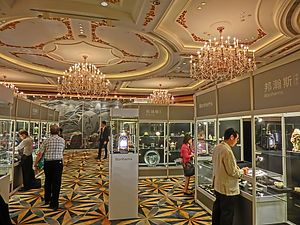Taikang Insurance’s investment in Sotheby’s auction house solidifies China’s position as the world’s largest market for arts and antiquities. It is ironic that Taikang’s head, Chen Dongsheng, grandson-in-law of Chairman Mao Zedong, would invest in a 270 year-old firm that is synonymous with bourgeois decadence.
For Chen, the visionary CEO of Taikang and founder of China’s second largest auction house, culture is a highly profitable business. As other Chinese companies follow his lead, China will become the primary destination for the world’s culture. China is taking on the mantle of custodian of the world’s heritage — as such, it must establish itself as a responsible stakeholder in safeguarding our shared history.
In Mao’s era, culture was simply a means of propaganda to brainwash the masses. Mao said that “literature and art fit well into the whole revolutionary machine… they operate as powerful weapons for uniting and educating the people.” Culture was a means to promote the party, and the Ministry of Propaganda controlled all aspects of the “industry” – newspapers, films, TV and, of course, art.
How times have changed. In 2009, the Chinese government designated “culture” as a strategic industry. Today, China is on track to dominate this vast and profitable industry. Nowhere is that rise more apparent than in the art market.
In part a reaction to China’s economic slowdown, President Xi Jinping has actively encouraged Chinese companies to invest overseas. In 2016, investments are expected to hit record levels of between $20- $30 billion in the United States alone. These are up from just $11.9 billion two years previously.
Chinese collectors are newcomers to the fine arts world, but as is often the case with China, collecting has caught on in a big way quickly. Even though China only recently opened its door to foreign auction houses, it has rapidly become the largest art market in the world, just ahead of the United States and the United Kingdom. And it continues to boom. While the two art market capitals of the world — New York and London — were down last year by 49 percent and 30 percent respectively, acquisitions by Chinese collectors rose almost 20 percent.
A large part of this jump is due to government policy. In an effort to compete with the great cities of the world, all of which have internationally renowned museums, China has gone on a building spree. The government hit its goal of building 3,500 of these symbols of stature by 2012, three years ahead of schedule, and continues to build museums at a record pace. Additional private museums built by the newfound wealthy class in China are also springing up across the country. In contrast, the United States establishes about 20-30 new museums a year. Yet China still has a long way to go to catch up with the United States, which has over 35,000 museums.
China’s opportunity — and challenge — is that its new museums needs to be filled. And there are simply not enough Chinese domestic art and antiquities to meet this demand. Logically, overseas collections will be in high pursuit by the museums, collectors, dealers, and auction houses.
Today, six of the top ten global auction houses in the world are Chinese. Chen Dongsheng, who modeled his own auction house, China Guardian, after Sotheby’s, is the logical man to set high standards for collecting, especially in verifying the authenticity and legitimacy of what his firm sells. In addition to founding China Guardian, Chen’s investment makes Taikang Insurance Sotheby’s largest shareholder.
There is concern that others will not follow Taikang’s example. The crisis in the Middle East and the use of antiquities trafficking by violent extremist organizations to fund their terrorism has led to a proliferation of conflict antiquities on the market. Demand countries such as the United States and Europe have taken steps to close their markets to these conflict antiquities. Given the rapidly growing demand of the Chinese market for antiquities, increasingly including those from the Middle East, China could become a major source of terrorist financing if strict standards for acquisition are not upheld.
State-owned auction houses such as Poly International, the world’s third largest auction house after Sotheby’s and Christie’s, must guarantee a world-class verification process to ensure the legitimacy of the antiquities that they are selling, particularly those coming from countries in conflict. Poly International is a division of the Poly Group Corporation, one of the world’s largest arms traders. The corporation has a history of past transgressions, having been recently sanctioned by the United States for illegal arms shipments in violation of the Iran, North Korea, and Syria Nonproliferation Act.
As China positions itself as a world-renowned center of art and culture, it should take a strong stand against antiquities looting and trafficking, particularly from countries in conflict. China knows only too well the impact of having its cherished history looted and destroyed. Even today, China is seeking to repatriate antiquities looted by French and British troops from the Old Summer Palace in the 1860s. Banning the purchase of conflict antiquities will do more to establish China’s authority in the world of art than any monumental edifice filled with exquisite, but stolen property.
Deborah Lehr is Chairman and Founder of The Antiquities Coalition.
Katie Paul is Chief of Staff, The Antiquities Coalition.

































